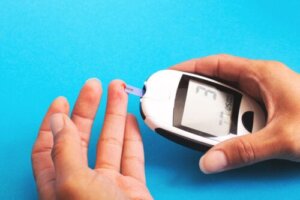Estimated Average Glucose: What Is it and Why Is It Important?


Reviewed and approved by the nurse Leidy Mora Molina
The estimated average glucose or eAG is a figure that represents the estimated average value of sugar (glucose) in the blood, during a period of 2 to 3 months. Such a figure is calculated based on the results of a blood test known as glycosylated hemoglobin (HbA1c or A1c).
It’s important to keep in mind that blood glucose levels are not constant, but vary throughout the day. Therefore, a single measurement can be misleading.
Those who benefit most from the calculation of estimated average glucose are people living with diabetes. These patients require continuous monitoring and the eAG provides reliable values.
What is estimated average glucose?
Estimated average glucose refers to the average of blood sugar levels over 60 or 90-day periods. The results are expressed in milligrams per deciliter (mg/dL) or millimoles per liter (mmol/L).
Long-term blood sugar is measured by the A1c blood test. This test detects the percentage of glycosylated hemoglobin.
Hemoglobin itself is a protein in red blood cells to which glucose is attached. The test determines the proportion of hemoglobin that has glucose bound to it.
To calculate the estimated average glucose, the results of the daily measurement and the A1c test are taken and a formula is applied. The method helps in the following ways:
- Allows diagnosis of prediabetes and diabetes
- Suggests the need for changes in the approach to diabetes
- Corroborates the results of daily blood glucose measurement
- Helps establish whether the treatment plan is working
- Reveals how healthy lifestyle patterns affect blood sugar control

Read more: Diabetes and High Blood Pressure: What Can You Eat?
How to calculate it
The A1c test gives the results in percentage terms. These must be checked against the milligrams of sugar in each deciliter of blood, which is the way the glucose meter gives the values each day.
There’s a formula to translate A1c test values into eAG or estimated average glucose values. The formula is as follows:
eAG = 28.7 x A1c – 46.7
An easy way to establish the estimated average glucose is to go to an online calculator, such as the one from the American Diabetes Association. The following table of values, which has first the A1c value, then the eAG equivalent in mg/dL, can also be taken as a reference point:
- 4 = 68
- 5 = 97
- 6 = 126
- 7 = 154
- 8 = 183
- 9 = 212
- 10 = 240
- 11 = 269
- 12 = 298
Interpreting the results
High estimated average glucose values indicate high blood sugar levels. According to the American Diabetes Association, the basic interpretation of eAG is as follows:
- Normal range: Less than 114 mg/dL
- Prediabetes: More than 114 mg/dL and less than 140 mg/dL
- Diabetes: More than 140 mg/dL
Almost all blood glucose meters used for daily testing offer the ability to average readings over the past few weeks or months. However, that calculation isn’t the same as the estimated average glucose. In fact, it may be higher or lower.
This is often due to the patient testing at times when blood sugar is low, such as before eating, or when it’s very high, when eating.
The estimated average glucose value is more reliable. However, it should be analyzed in conjunction with A1c results.
You might also be interested in: Four Desserts for Diabetics
Facts to keep in mind about estimated average glucose
According to the American Diabetes Association, it’s best to test your A1c blood twice a year. If treatment isn’t working or a change in dosage is made, it should be carried out 4 times that year.
Daily diabetes monitoring should always be maintained, as it provides a snapshot. However, it does not provide valid long-term data.
The information provided by daily monitoring is essential to adjust aspects such as insulin requirement, physical activity level, and food intake. Both A1c testing and estimated average glucose are adjuncts to daily monitoring and not substitutes for it.
There are some medical conditions that may alter the relationship between A1c test results and estimated average glucose. The eAG should not be used in the following cases:
- Patients with anemia or thalassemia
- People with kidney disease
- Patients with sickle cell disease
- Persons taking medication with iron, dapsone, or erythropoietin

Measurements to be better
It’s usual for the doctor to set a target estimated average glucose. This is determined based on the individual’s health status, age, and additional influencing factors.
Continually measuring blood sugar levels through daily monitoring, A1c testing, and estimated average glucose can be overwhelming. It’s always good to remember that it isn’t all about the numbers, as they are only a benchmark for improving quality of life.
All cited sources were thoroughly reviewed by our team to ensure their quality, reliability, currency, and validity. The bibliography of this article was considered reliable and of academic or scientific accuracy.
- A1C does it all. (s. f.). American Diabetes Asociation. https://diabetes.org/diabetes/a1c.
- American Diabetes Association; 6. Glycemic Targets: Standards of Medical Care in Diabetes—2021. Diabetes Care 1 January 2021; 44 (Supplement_1): S73–S84. https://doi.org/10.2337/dc21-S006.
- Castro Morán, L. R., & Huayamave Hidalgo, W. N. (2019). Comparación de la glicemia media estimada vs la hemoglobina glicosilada en pacientes diabéticos tipo II y no diabéticos (Doctoral dissertation, Universidad de Guayaquil. Facultad de Ciencias Químicas).
This text is provided for informational purposes only and does not replace consultation with a professional. If in doubt, consult your specialist.








